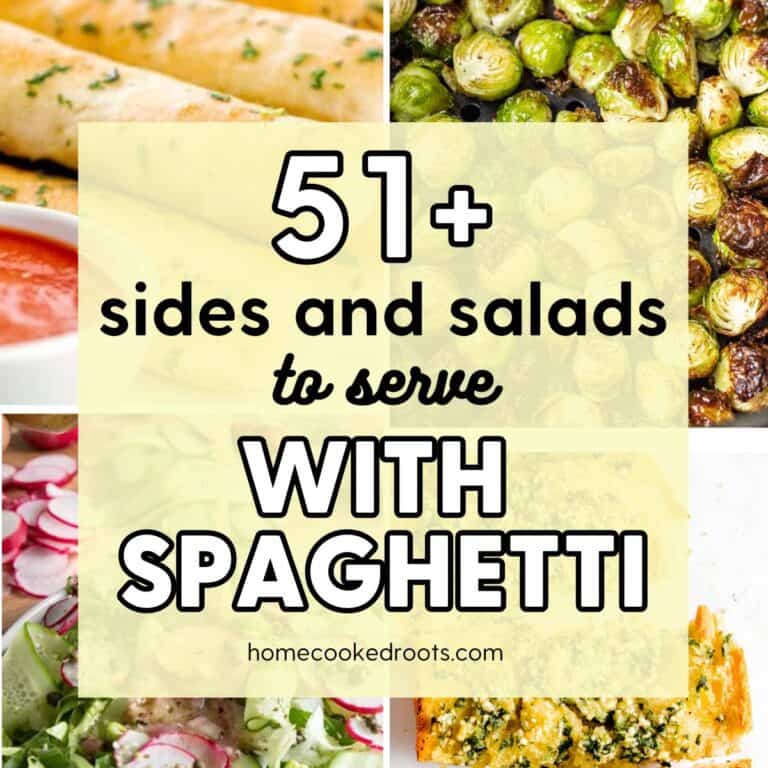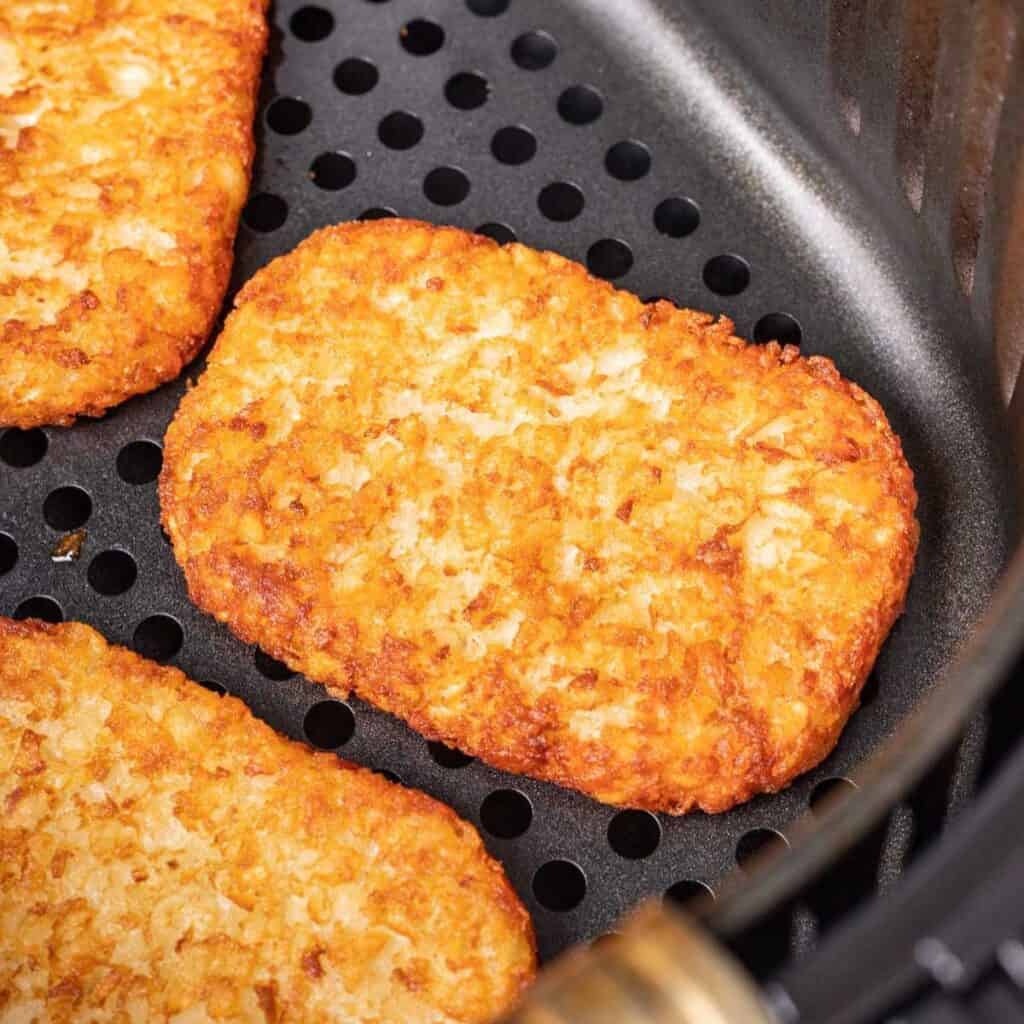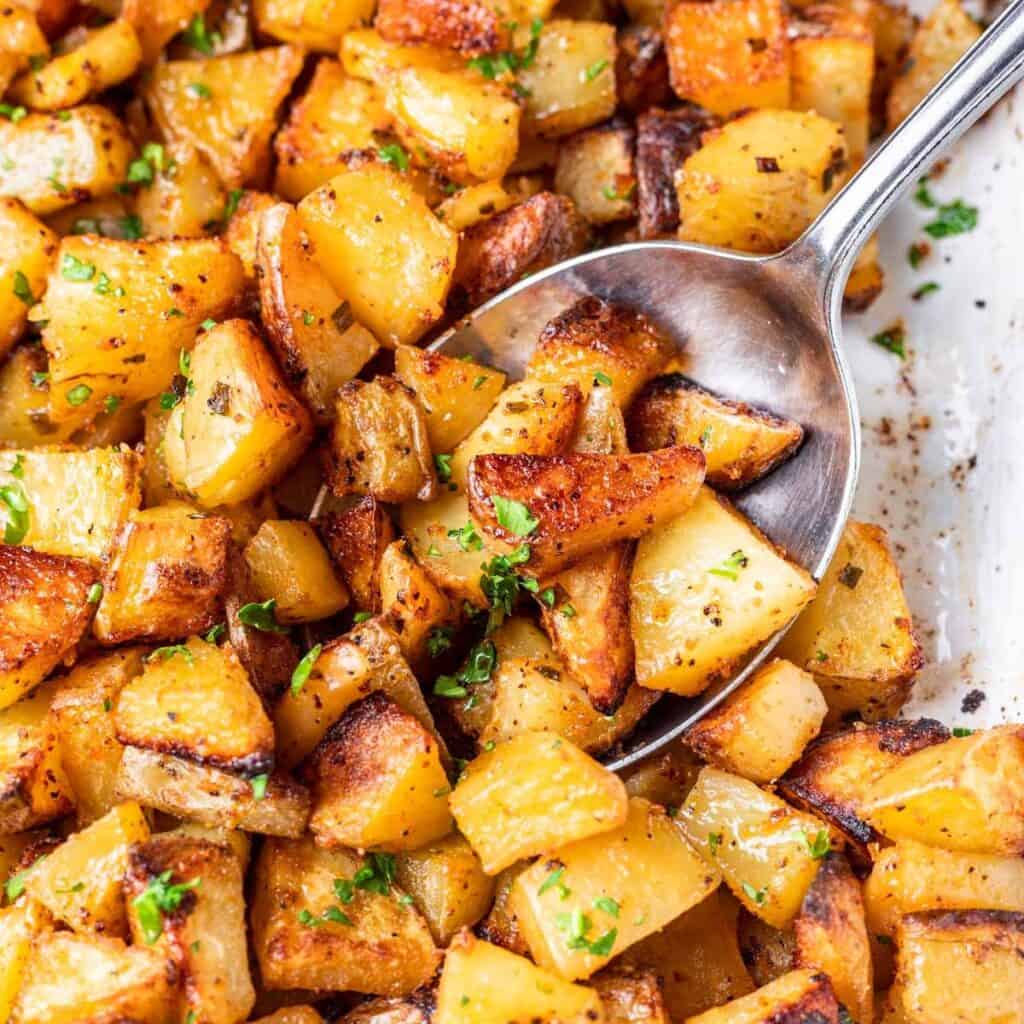This post may contain affiliate links. By browsing this website, you agree to our privacy policy and terms of use.
Wondering how to calculate how much you should spend on grocery shopping each month? There’s no magic number that will work for every person or family, but in this post, I’ve included a few helpful calculations and tips to help you settle on a reasonable monthly budget that will work for you.

USDA Monthly Food Plan Guidelines
Every month, the USDA (United States Department of Agriculture) publishes monthly food plans that provide an average cost of groceries for individuals and families at different income levels. Each plan’s pricing is based on eating a balanced, nutritious diet and is adjusted every month using the Consumer Price Index to account for inflation.
Below are general guidelines for your monthly grocery budget, broken down into four different budget levels: Thrifty, Low-Cost, Moderate and Liberal budgets adjusted for family size.
Food Budget Guidelines for a Single-Person Household
Shopping for a single person household will always be more expensive than shopping for a larger household because larger households can take advantage of the economies of scale. Buying in bulk is always cheaper than purchasing just 1 or 2. Leftovers are also a lot easier to manage in a larger household and result in less monthly spending.
For this reason, the USDA recommends adding 20% to their guidelines when shopping as a single-person household. Here is a general guideline for women and men with the additional 20% added in:
Women
- Thrifty Plan: $242.50 per month
- Low-Cost Plan: $313.44 per month
- Moderate-Cost Plan: $382.20 per month
- Liberal Plan: $487.68 per month
Men
- Thrifty Plan: $304.00 per month
- Low-Cost Plan: $361.44 per month
- Moderate-Cost Plan: $437.28 per month
- Liberal Plan: $550.08 per month
Food Budget Guidelines for a Two-Person Household
Similarly to shopping as a single person, shopping for a two-person household is slightly more expensive than shopping for a family of 4+. The USDA recommends adding 10% to their guidelines when shopping for a family of 2. Here’s the USDA guidelines:
- Thrifty Plan: $546.50 per month
- Low-Cost Plan: $600.76 per month
- Moderate-Cost Plan: $764.94 per month
- Liberal Plan: $951.28 per month
Food Budget Guidelines for a Family of Four
This example budget is based off of a family with 1 adult male, 1 adult female, and two children, 6-8 and 9-11 years old.
- Thrifty Plan: $976.60 per month
- Low-Cost Plan: $1,059.40 per month
- Moderate-Cost Plan: $1,312.50 per month
- Liberal Plan: $1,585.20 per month
Budgeting in Hawaii and Alaska
The above guidelines are for people living in the lower 48. If you are living in Hawaii and Alaska, the USDA recommendation is to increase the above numbers by 25%-30% to account for higher cost of living.
Budgeting for Larger Families
If you are a family of 5 or larger, the USDA recommends making the following adjustments to their calculations based on the size of your household:
- 5-6 person household: Subtract 5%
- 7+ person household: Subtract 10%
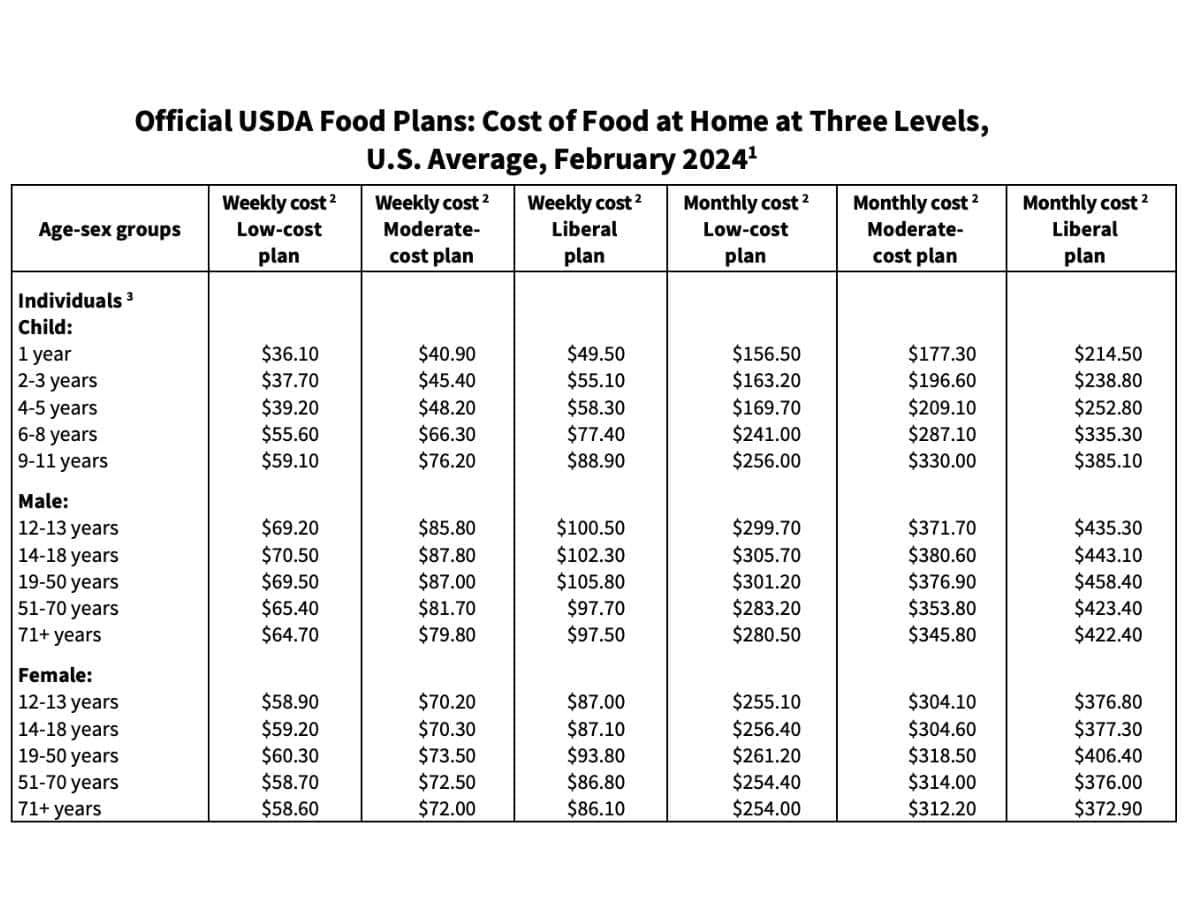
Do These Guidelines Include Household Items?
A number of families will lump all of their other household expenses into their grocery budget, like pet food, paper towels, toilet paper, dish soap, etc.
But please note that these guidelines are for food items only. They do not account for dining out or other miscellaneous household purchases. Those costs would be additional expenses on top of these numbers.
Are these Numbers Reasonable?
Whether or not these numbers are reasonable will depend on a multitude of different factors and your personal situation. For example, if you’re dead set on only purchasing organic produce and eating grass fed meat at every meal, you’re going to pay higher food prices than families that are open to occasionally swapping the meat for beans or buying conventional produce from the Clean 15 List.
Evaluate what you are currently spending and ask yourself if you are comfortable with it. If what you’re spending on food each month is not impeding on your ability to achieve your financial goals, I wouldn’t worry much about it!
With that being said, as someone who has closely tracked my food spending since 2016, my personal opinion is that these guidelines are a bit on the high side, especially if you are shopping for a family of 4 or more.
I live in the San Francisco Bay Area, one of the most expensive areas in the country, and can confidently say that most families can eat an abundant, nutritious diet while spending between the Thrifty and Low-Cost Plan Guidelines.
My husband and I eat a plant-based diet focused on fresh produce and health-promoting foods and our average weekly grocery bill always fits under the Low-Cost plan guidelines, even when we have a lot of bulk buys at Costco. On a week to week basis, we’re usual under the frugal plan guidelines, and that’s includes buying a considerable amount of fresh produce.
If you are well over these numbers and want to make some changes, I have good news! There are several ways you can decrease your grocery budget and start seeing savings IMMEDIATELY.
We Have So Much Control Over Our Grocery Spending!
Despite inflation, we have so much control over what we spend each month on food. For the average American household, food spending is the second largest spending category right behind our rent or mortgage.
What we spend on food is also one of the easiest things to decrease QUICKLY! We cannot easily change the cost of our fixed bills, but we can easily change what we spend on our monthly grocery bill (yes, this is STILL true in 2024!).
Easy Ways to Lower Your Food Costs

Stop Going out to Eat
The above spending guidelines are strictly for groceries, meaning what Americans are spending on restaurant meals is an additional cost. If you are trying to save money and lower your overall expenses, rethink the amount of times you visit a restaurant or coffee shop each month.
This habit is costing you 400% more than cooking meals at home. Even more if you’re using services like DoorDash. Trust me, I’ve done the painful math.
Skip the Beverages
It may not be fun to hear, but the only beverage we really need is water. If you are tight on money, skip purchasing soda, juice, alcohol, sparkling water, and expensive coffees and teas. You’ll be surprised how much you can save by making this one cut!
Shop at Cheaper Grocery Stores
Where you shop for your groceries every week can make or break your budget. By shopping at one of the cheaper grocery stores in your area, you can immediately see a decrease in spending!
Reduce your Meat Intake
Meat is one of the most expensive items at the grocery store and can quickly eat up your food budget. To save money and stretch your budget, try replacing half of the meat with lentils or beans. This works particularly well when making taco meat, burgers, egg roll in a bowl, sloppy joes, and more. Or, go all the way and incorporate a few meatless meals each week.
Buy Generic
The generic brands are almost always cheaper than the name brands. By switching to generic, you can see an immediate drop in cost.
Shop in Bulk
This won’t work for everyone, but even for my smaller family of 2, shopping in bulk for various non-perishables and household items saves us a lot of money year over year. If you have the storage space and the ability to pay a bit more upfront, you can reap some significant savings!
Cook from your pantry
If you’ve stocked the basic pantry essentials and some frozen produce, you should be able to make a number of basic meals like pasta, rice and beans, curry, and more. Challenge yourself to use up what’s in the pantry before heading to the grocery store.
Make a Grocery List…and stick to it!
Creating a meal plan and shopping list before heading to the grocery store is one of the best ways to make sure you’re sticking to the necessities and avoiding impulse buys. As the saying goes, when you fail to prepare, you prepare to fail. If you need a helpful guide, check out a few of my example meal plans!
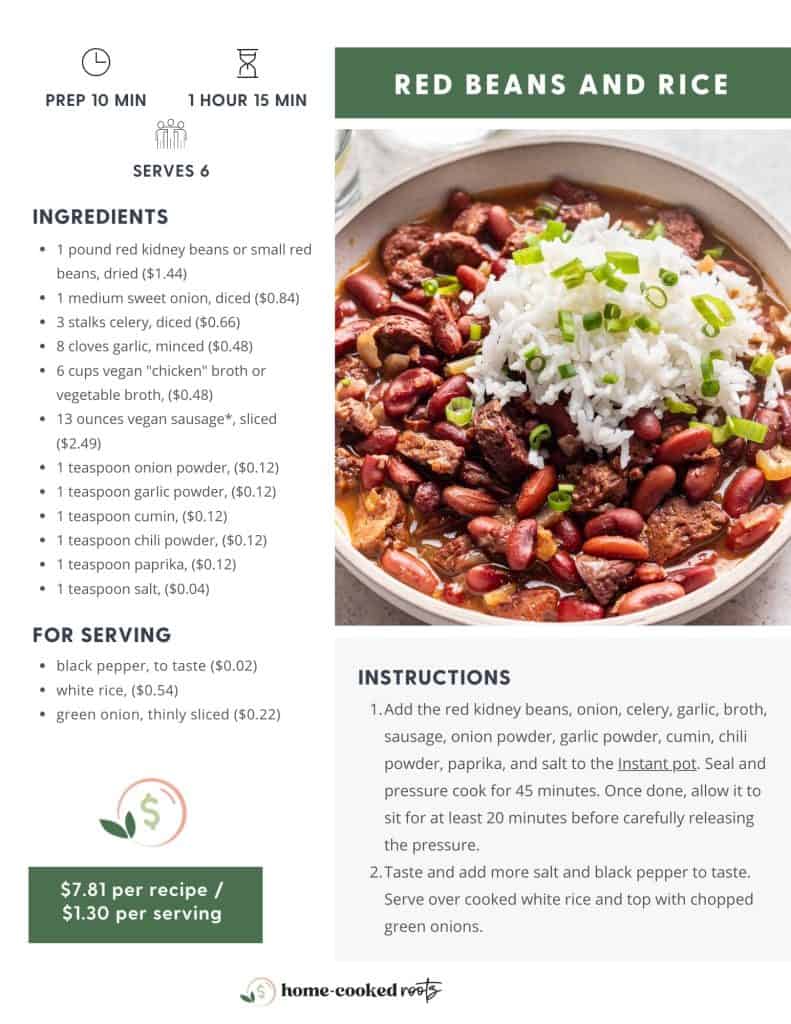

Free ebook
Wallet-Friendly Recipes & Smart Shopping Tips in Your Inbox
Plus get a free cookbook with 12 Dirt Cheap Dinner Ideas that’ll cost you $2 or less per serving.



